Effects of Grazing, Extreme Drought, Extreme Rainfall and Nitrogen Addition on Vegetation Characteristics and Productivity of Semiarid Grassland
Abstract
1. Introduction
2. Materials and Methods
2.1. Study Area
2.2. Experimental Design and Measuring
2.3. Vegetation Characteristics Investigation and Soil Water and Nitrogen Content Determination
2.4. Methods for Measuring Plant Species Diversity
2.5. Plant Community Height (CWMheight)
2.6. Data Analysis
3. Results and Analysis
3.1. Plant Importance Values of Sandy Grassland under Fencing under Rainfall Changes, Nitrogen Addition and Their Interaction
3.2. Plant Importance Values of Sandy Grassland under Grazing under Rainfall Changes, Nitrogen Addition and Their Interaction
3.3. Effects of Grazing, Rainfall Changes, Nitrogen Addition and Their Interactions on Vegetation Characteristics in the Sandy Grassland
3.4. Effects of Grazing, Rainfall Changes, Nitrogen Addition on Productivity in the Sandy Grassland
4. Discussion
5. Conclusions
Supplementary Materials
Author Contributions
Funding
Institutional Review Board Statement
Informed Consent Statement
Data Availability Statement
Acknowledgments
Conflicts of Interest
References
- Guo, X.X.; Zuo, X.A.; Yue, P.; Li, X.Y.; Hu, Y.; Chen, M.; Yu, Q. Direct and indirect efects of precipitation change and nutrients addition on desert steppe productivity in Inner Mongolia, northern China. Plant Soil 2022, 471, 527–540. [Google Scholar] [CrossRef]
- Piao, S.L.; Ciais, P.; Huang, Y.; Shen, Z.; Peng, S.; Li, J. The impacts of climate change on water resources and agriculture in China. Nature 2010, 467, 43–51. [Google Scholar] [CrossRef]
- Wang, R.; Kalin, L.; Kuang, W.; Tian, H. Individual and combined effects of land use/cover and climate change on Wolf Bay watershed streamflow in southern Alabama. Hydrol. Process. 2014, 28, 5530–5546. [Google Scholar] [CrossRef]
- Fay, P.A.; Prober, S.M.; Harpole, W.S.; Knops, J.M.; Bakker, J.D.; Borer, E.T.; Lind, E.M.; MacDougall, A.S.; Seabloom, E.W.; Wragg, P.D.; et al. Grassland productivity limited by multiple nutrients. Nat. Plants 2015, 1, 15080. [Google Scholar] [CrossRef]
- Luo, W.T.; Zuo, X.A.; Griffin-Nolan, R.J.; Xu, C.; Knapp, A.K. Long term experimental drought alters community plant trait variation, not trait means, across three semiarid grasslands. Plant Soil 2019, 442, 343–353. [Google Scholar] [CrossRef]
- Su, Y.Z.; Li, Y.L.; Cui, J.Y.; Zhao, W.Z. Influences of continuous grazing and livestock exclusion on soil properties in a de-graded sandy grassland, Inner Mongolia, northern China. Catena 2005, 59, 267–278. [Google Scholar]
- Concostrina-Zubiri, L.; Huber-Sannwald, E.; Martinez, I.; Flores, J.L.F.; Escudero, A. Biological soil crusts greatly contribute to small-scale soil heterogeneity along a grazing gradient. Soil Biol. Biochem. 2013, 64, 28–36. [Google Scholar] [CrossRef]
- Jing, Z.B.; Cheng, J.M.; Su, J.S.; Bai, Y.; Jin, J.W. Changes in plant community composition and soil properties under 3-decade grazing exclusion in semiarid grassland. Ecol. Eng. 2014, 64, 171–178. [Google Scholar] [CrossRef]
- Oconnor, T.G.O.; Pickett, G.A. The Influence of Grazing on Seed Production and Seed Bank of Some African Savanna Grassland. J. Appl. Ecol. 1992, 29, 247–260. [Google Scholar] [CrossRef]
- Yang, X.; Yan, X.; Guo, Q.; Ghanizadeh, H.; Li, M.; Tuo, H.; Wen, Z.; Li, W. Effects of different management practices on plant com-munity and soil properties in a restored grassland. J. Soil Sci. Plant Nutr. 2022, 22, 3811–3821. [Google Scholar] [CrossRef]
- Hao, Y.; He, Z. Effects of grazing patterns on grassland biomass and soil environments in China: A me-ta-analysis. PLoS ONE 2019, 14, e0215223. [Google Scholar] [CrossRef] [PubMed]
- Qiao, Y.M.; Wang, Q.J.; Wang, W.Y. Yak (Bos grunniens L.) Grazing effects on vegetation of alpine meadow with Potentilla fruticosa L. (rosaceae) shrub in qinghai-tibet plateau. Pol. J. Ecol. 2009, 57, 769–777. [Google Scholar]
- IPCC. Managing the Risks of Extreme Events and Disasters to Advance Climate Change Adaptation (SREX); Cambridge University Press: Cambridge, UK, 2011. [Google Scholar]
- Jin, H.; Yan, X.; Sun, S.; Zhang, J. Spatial and temporal variability of drought during 1960–2012 in Inner Mongolia, north China. Quat. Int. 2015, 355, 134–144. [Google Scholar]
- Easterling, D.R.; Meehl, G.A.; Parmesan, C.; Changnon, S.A.; Karl, T.R.; Mearns, L.O. Climate extremes: Observations, modeling, and impacts. Science 2000, 289, 2068–2074. [Google Scholar] [CrossRef]
- He, Y.L.; Wang, J.S.; Tian, D.; Quan, Q.; Jiang, L.; Ma, F.F. Long-term drought aggravates instability of alpine grassland productivity to extreme climatic event. Ecology 2022, e3792. [Google Scholar] [CrossRef]
- Miranda, J.D.D.; Padilla, F.M.; Lázaro, R.; Pugnaire, F.I. Do changes in rainfall patterns affect semiarid annual plant com-munities? J. Veg. Sci. 2009, 20, 269–276. [Google Scholar] [CrossRef]
- Choat, B.; Jansen, S.; Brodribb, T.J.; Cochard, H.; Delzon, S.; Bhaskar, R.; Bucci, S.J.; Field, T.S.; Gleason, S.M.; Hacke, U.G.; et al. Global convergence in the vulnerability of forests to drought. Nature 2012, 491, 752–755. [Google Scholar] [CrossRef]
- Wang, C.; Wan, S.; Xing, X.; Zhang, L.; Han, X. Temperature and soil moisture interactively affected soil net N mineralization in temperate grassland in Northern China. Soil Biol. Biochem. 2006, 38, 1101–1110. [Google Scholar] [CrossRef]
- Zhang, Z.Z.; Shan, L.S.; Li, Y. Prolonged dry periods between rainfall events shorten the growth period of the resurrection plant Reaumuria soongorica. Ecol. Evol. 2018, 8, 920–927. [Google Scholar] [CrossRef]
- Galloway, J.N.; Townsend, A.R.; Erisman, J.W.; Bekunda, M.; Cai, Z.; Freney, J.R.; Martinelli, L.A.; Seitzinger, S.P.; Sutton, M.A. Transformation of the Nitrogen Cycle: Recent Trends, Questions, and Potential Solutions. Science 2008, 320, 889–892. [Google Scholar] [CrossRef] [PubMed]
- Liu, X.; Zhang, Y.; Han, W.; Tang, A.; Shen, J.; Cui, Z.; Vitousek, P.; Erisman, J.W.; Goulding, K.; Christie, P.; et al. Enhanced nitrogen deposition over China. Nature 2013, 494, 459–462. [Google Scholar] [CrossRef]
- Gao, Y.Z.; Chen, Q.; Lin, S.; Giese, M.; Brueck, H. Resource manipulation effects on net primary production, biomass allocation and rain-use efficiency of two semiarid grassland sites in Inner Mongolia, China. Oecologia 2011, 165, 855–864. [Google Scholar] [CrossRef]
- He, K.J.; Huang, Y.M.; Qi, Y.; Sheng, Z.L.; Chen, H.Y. Effects of nitrogen addition on vegetation and soil and its linkages to plant diversity and productivity in a semi-arid steppe. Sci. Total Environ. 2021, 778, 146299. [Google Scholar] [CrossRef]
- Stevens, C.J.; Lind, E.M.; Hautier, Y.; Harpole, W.S.; Borer, E.T.; Hobbie, S. Anthropogenic nitrogen deposition predicts local grassland primary production worldwide. Ecology 2015, 96, 1459–1465. [Google Scholar] [CrossRef]
- Stevens, C.J.; Dise, N.B.; Mountford, J.O.; Gowing, D.J. Impact of nitrogen deposition on the species richness of grasslands. Science 2004, 303, 1876–1879. [Google Scholar] [CrossRef]
- Clark, C.M.; Tilman, D. Loss of plant species after chronic low-level nitrogen deposition to prairie grasslands. Nature 2008, 451, 712–715. [Google Scholar] [CrossRef]
- Bai, Y.; Wu, J.; Clark, C.M.; Naeem, S.; Pan, Q.; Huang, J.; Zhang, L.; Han, X. Tradeoffs and thresholds in the effects of nitrogen addition on biodi-versity and ecosystem functioning: Evidence from inner Mongolia Grasslands. Glob. Chang. Biol. 2010, 16, 358–372. [Google Scholar] [CrossRef]
- Lebauer, D.S.; Treseder, K.K. Nitrogen limitation of net primary productivity in terrestrial ecosystems is globally distributed. Ecology 2008, 89, 371–379. [Google Scholar] [CrossRef] [PubMed]
- Yu, K.L.; D’Odorico, P.; Carr, D.E.; Personius, A. The effect of nitrogen availability and water conditions on competition between a facultative CAM plant and an invasive grass. Ecol. Evol. 2017, 7, 7739–7749. [Google Scholar] [CrossRef]
- Cheng, K.; Hu, Z.; Li, S.; Guo, Q.; Hao, Y.; Yuan, W. Improvement of predicting ecosystem productivity by modifying carbon–water–nitrogen coupling processes in a temperate grassland. J. Plant Ecol. 2020, 14, 10–21. [Google Scholar] [CrossRef]
- Sirulnik, A.G.; Allen, E.B.; Meixner, T.; Allen, M.F. Impacts of anthropogenic N additions on nitrogen mineralization from plant litter in exotic annual grasslands. Soil Biol. Biochem. 2007, 39, 24–32. [Google Scholar] [CrossRef]
- Liu, W.; Zhang, Z.; Wan, S. Predominant role of water in regulating soil and microbial respiration and their responses to climate change in a semiarid grassland. Glob. Chang. Biol. 2010, 15, 184–195. [Google Scholar] [CrossRef]
- Kong, D.L.; Lu, X.T.; Jiang, L.L.; Wu, H.F.; Miao, Y.; Kardol, P. Extreme rainfall events can alter inter-annual biomass responses to water and N enrichment. Biogeosciences 2013, 10, 8129–8138. [Google Scholar] [CrossRef]
- Wardle, D.A.; Bardgett, R.D.; Klironomos, J.N.; Setala, H.; van der Putten, W.H.; Wall, D.H. Ecological linkages between aboveground and belowground biota. Science 2004, 304, 1629–1633. [Google Scholar] [CrossRef]
- Hoover, D.L.; Duniway, M.C.; Belnap, J. Pulse-drought atop press-drought: Unexpected plant responses and implications for dryland ecosystems. Oecologia 2015, 179, 1211–1221. [Google Scholar] [CrossRef]
- Lu, H.; Ge, S.; Liu, Y. Effects of precipitation on grassland ecosystem restoration under grazing exclusion in Inner Mongolia, China. Landsc. Ecol. 2014, 29, 1657–1673. [Google Scholar]
- Hovenden, M.J.; Leuzinger, S.; Newton, P.; Fletcher, A.; Fatichi, S.; Lüscher, A. Globally consistent influences of seasonal precipitation limit grassland biomass response to elevated CO2. Nat. Plants 2019, 5, 167–173. [Google Scholar] [CrossRef] [PubMed]
- Bagan, H.; Takeuchi, W.; Kinoshita, T.; Bao, Y.; Yamagata, Y. Land Cover Classification and Change Analysis in the Horqin Sandy Land From 1975 to 2007. IEEE J. Sel. Top. Appl. Earth Obs. Remote Sens. 2010, 3, 168–177. [Google Scholar] [CrossRef]
- Huang, W.; Zhao, X.; Zhao, X.; Li, X.; Zuo, X.; Lian, Z.; Luo, Y. Genetic diversity in Artemisia halodendron (Asteraceae) based on chloroplast DNA psbA–trnH region from different hydrothermal conditions in Horqin sandy land, northern China. Plant Syst. Evol. 2013, 299, 107–113. [Google Scholar] [CrossRef]
- Zhang, J.; Zuo, X.; Zhao, X.; Ma, J.; Medina-Roldán, E. Effects of rainfall manipulation and nitrogen addition on plant biomass allocation in a semiarid sandy grassland. Sci. Rep. 2020, 10, 9026. [Google Scholar] [CrossRef]
- Li, Y.; Han, J.; Wang, S.; Brandle, J.; Lian, J.; Luo, Y. Soil organic carbon and total nitrogen storage under different land uses in the Naiman Banner, a semiarid degraded region of northern China. Can. J. Soil Sci. 2014, 94, 9–20. [Google Scholar] [CrossRef]
- Wen, J.; Qin, R.; Zhang, S.; Yang, X.; Manhou, X.U. Effects of long-term warming on the aboveground biomass and species di-versity in an alpine meadow on the Qinghai-Tibetan Plateau of China. J. Arid Land 2020, 12, 252–266. [Google Scholar] [CrossRef]
- Zheng, K.; Wei, J.Z.; Pei, J.Y.; Cheng, H.; Zhang, X.L.; Huang, F.Q. Impacts of climate change and human activities on grassland vegetation variation in the Chinese Loess Plateau. Sci. Total Environ. 2019, 660, 236–244. [Google Scholar] [CrossRef]
- Tilman, D.; Knops, J.; Wedin, D.; Reich, P.; Ritchie, M.; Siemann, E. The influence of functional diversity and composition on ecosystem pro-cesses. Science 1997, 277, 1300–1302. [Google Scholar] [CrossRef]
- Ye, R.; Liu, G.; Chang, H.; Shan, Y.; Li, F. Response of plant traits of Stipa breviflora to grazing intensity and fluctuation in annual precipitation in a desert steppe, northern China. Glob. Ecol. Conserv. 2020, e01237. [Google Scholar] [CrossRef]
- Zuo, X.; Jing, Z.; Lv, P.; Wang, S.; Yang, Y.; Yue, X. Effects of plant functional diversity induced by grazing and soil properties on above- and belowground biomass in a semiarid grassland. Ecol. Indic. 2018, 93, 555–561. [Google Scholar] [CrossRef]
- Chuan, X.Z.; Carlyle, C.N.; Bork, E.W.; Chang, S.X.; Hewins, D.B. Long-term grazing accelerated litter decomposition in Northern Temperate Grasslands. Ecosystems 2018, 21, 1321–1334. [Google Scholar] [CrossRef]
- Hanke, W.; Bohner, J.; Dreber, N.; Jurgens, N.; Schmiedel, U.; Wesuls, D.; Dengler, J. The impact of livestock grazing on plant diversity: An analysis across dryland ecosystems and scales in southern Africa. Ecol. Appl. 2014, 24, 1188–1203. [Google Scholar] [CrossRef]
- Stohlgren, T.J.; Crosier, C.; Chong, G.W.; Guenther, D.; Evangelista, P. Life-history habitat matching in invading non-native plant species. Plant Soil 2005, 277, 7–18. [Google Scholar] [CrossRef]
- Holdo, R.M.; Holt, R.D.; Coughenour, M.B.; Ritchie, M.E. Plant productivity and soil nitrogen as a function of grazing, mi-gration and fire in an African savanna. J. Ecol. 2010, 951, 115–128. [Google Scholar]
- Goodwillie, C.; McCoy, M.W.; Peralta, A.L. Long-term nutrient enrichment, mowing, and ditch drainage interact in the dynamics of a Wetland plant community. Bull. Ecol. Soc. Am. 2021, 10, e03252. [Google Scholar] [CrossRef]
- Wang, H.; Ta, N.; Jin, K.; Ji, B.; Wang, Z. Interactive effects of nitrogen fertilizer and altered precipitation on fungal communities in arid grasslands of northern China. J. Soils Sediments 2020, 20, 1–13. [Google Scholar] [CrossRef]
- Miao, R.H.; Miao, Y.; Liu, Y.L.; Guo, M.X.; Fu, G.Y.; Xiao, R.; Yang, Z.L.; Li, G.Y.; Chen, Z.J.; Han, S.J. Late-season drought exerts more negative effects on plant diversity and cover than early-season drought through changing soil moisture in a semi-arid grassland. J. Veg. Sci. 2022, 33, e13151. [Google Scholar] [CrossRef]
- Hernández, M.D.; Alfonso, C.; Cerrudo, A.; Cambareri, M.; Echarte, L. Eco-physiological processes underlying maize water use efficiency response to plant density under contrasting water regimes. Field Crops Res. 2020, 254, 107844. [Google Scholar] [CrossRef]
- Shi, Y.J.; Ao, Y.N.; Sun, B.X.; Knops, J.M.H.; Zhang, J.W.; Guo, Z.H. Productivity of Leymus chinensis grassland is co-limited by water and nitrogen and resilient to climate change. Plant Soil 2022, 474, 411–422. [Google Scholar] [CrossRef]
- Li, Z.; Zhang, Y.; Yu, D.; Zhang, N.; Lin, J.; Zhang, J. The influence of precipitation regimes and elevated CO2 on photosyn-thesis and biomass accumulation and partitioning in seedlings of the rhizomatous perennial grass Leymus chinensis. PLoS ONE 2014, 9, e103633. [Google Scholar]
- Li, X.; Zhang, X.; Wu, J.; Shen, Z.; Zhang, Y.; Xu, X. Root biomass distribution in alpine ecosystems of the northern Tibetan Plateau. Environ. Geol. 2011, 64, 1911–1919. [Google Scholar] [CrossRef]
- Zhou, X.; Talley, M.; Luo, Y. Biomass, litter, and soil respiration along a precipitation gradient in southern great plains, USA. Ecosystems 2009, 12, 1369–1380. [Google Scholar] [CrossRef]
- Meier, I.C.; Leuschner, C. Belowground drought response of European beech: Fine root biomass and carbon partitioning in 14 mature stands across a precipitation gradient. Glob. Chang. Biol. 2010, 14, 2081–2095. [Google Scholar] [CrossRef]
- Lu, P.; Hao, T.; Li, X.; Wang, H.; Zhai, X.; Tian, Q. Ambient nitrogen deposition drives plant-diversity decline by nitrogen accumulation in a closed grassland ecosystem. J. Appl. Ecol. 2021, 58, 1888–1898. [Google Scholar] [CrossRef]
- Ren, Z.; Qi, L.; Chu, C.; Zhao, L.; Zhang, J.; Ai, D. Effects of resource additions on species richness and ANPP in an alpine meadow community. J. Plant Ecol. 2010, 3, 25–31. [Google Scholar] [CrossRef]
- Zhong, M.X.; Miao, Y.; Han, S.; Wang, D. Nitrogen addition decreases seed germination in a temperate steppe. Ecol. Evol. 2019, 9, 8441–8449. [Google Scholar] [CrossRef]
- Chen, J.B.; Dong, C.C.; Yao, X.D.; Wang, W. Effects of nitrogen addition on plant biomass and tissue elemental content in different degradation stages of temperate steppe in northern China. J. Plant Ecol. 2017, 11, 730–739. [Google Scholar] [CrossRef]
- Fan, Z.P.; Tu, Z.H.; Li, F.Y.; Qin, Y.B.; Deng, D.Z.; Zeng, D.H. Experimental manipulation of precipitation affects soil nitrogen availability in Semiarid Mongolian Pine (Pinus sylvestris var. mongolica) Plantation. Water 2017, 9, 208. [Google Scholar] [CrossRef]
- Lü, F.M.; Lü, X.T.; Liu, W.; Han, X.; Zhang, G.M.; Kong, D.L. Carbon and nitrogen storage in plant and soil as related to nitrogen and water amendment in a temperate steppe of northern China. Biol. Fertil. Soils 2011, 47, 187–196. [Google Scholar] [CrossRef]
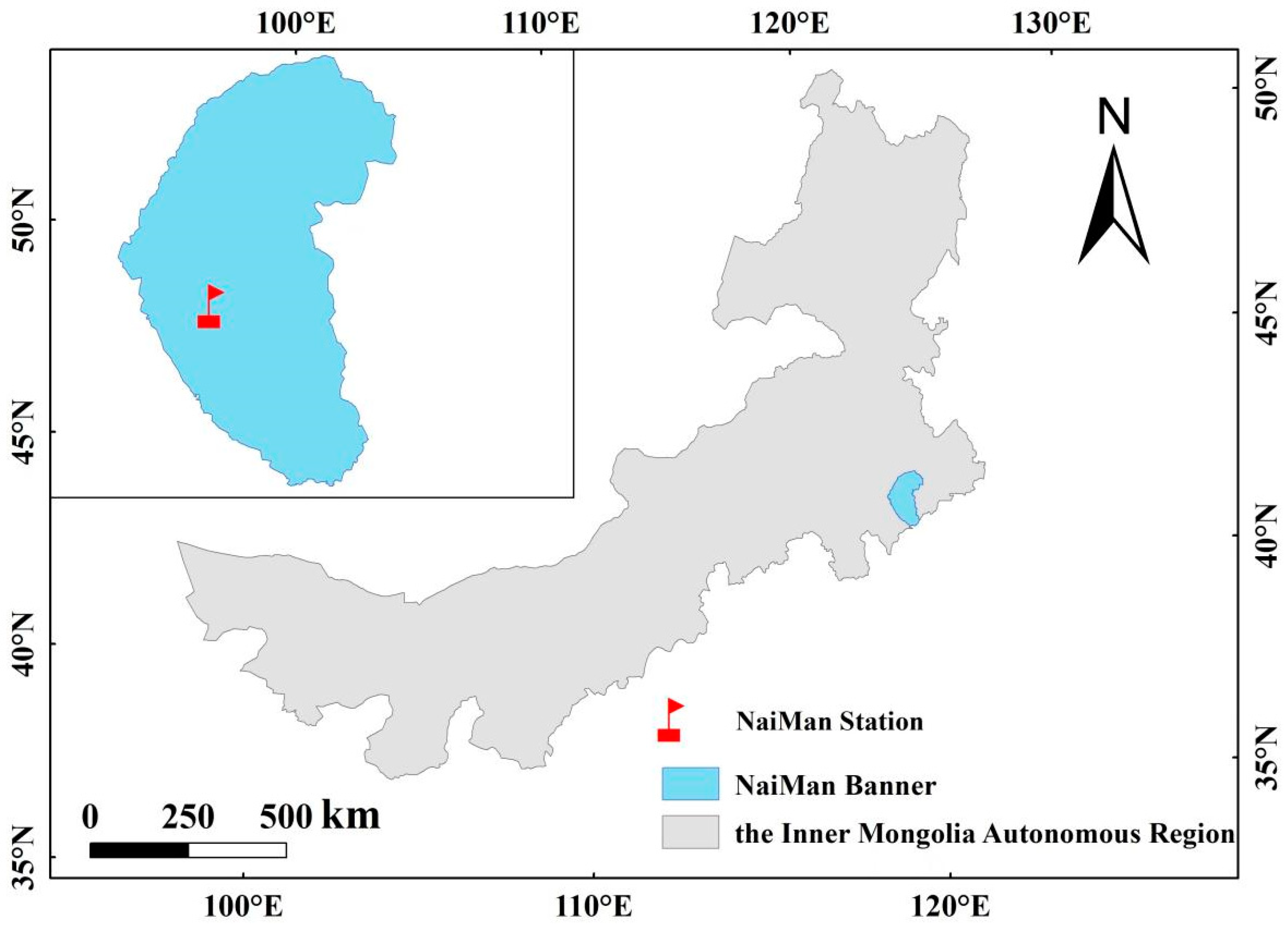
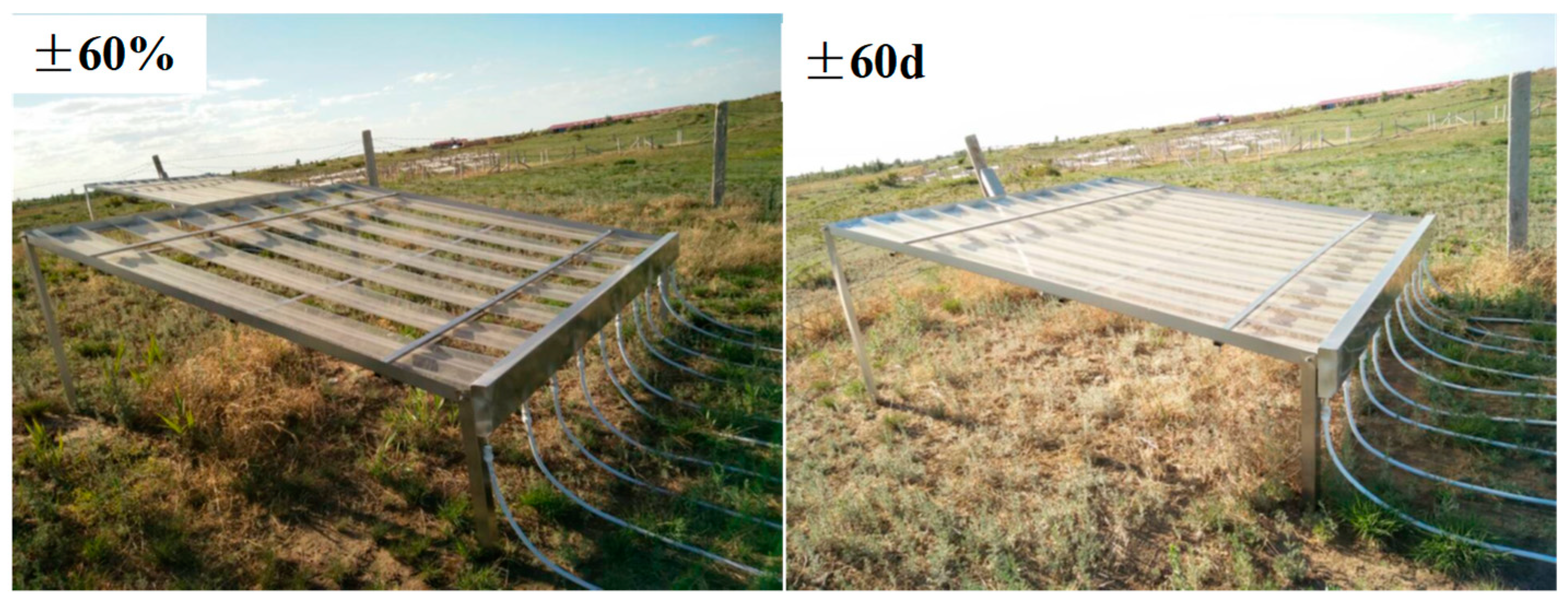
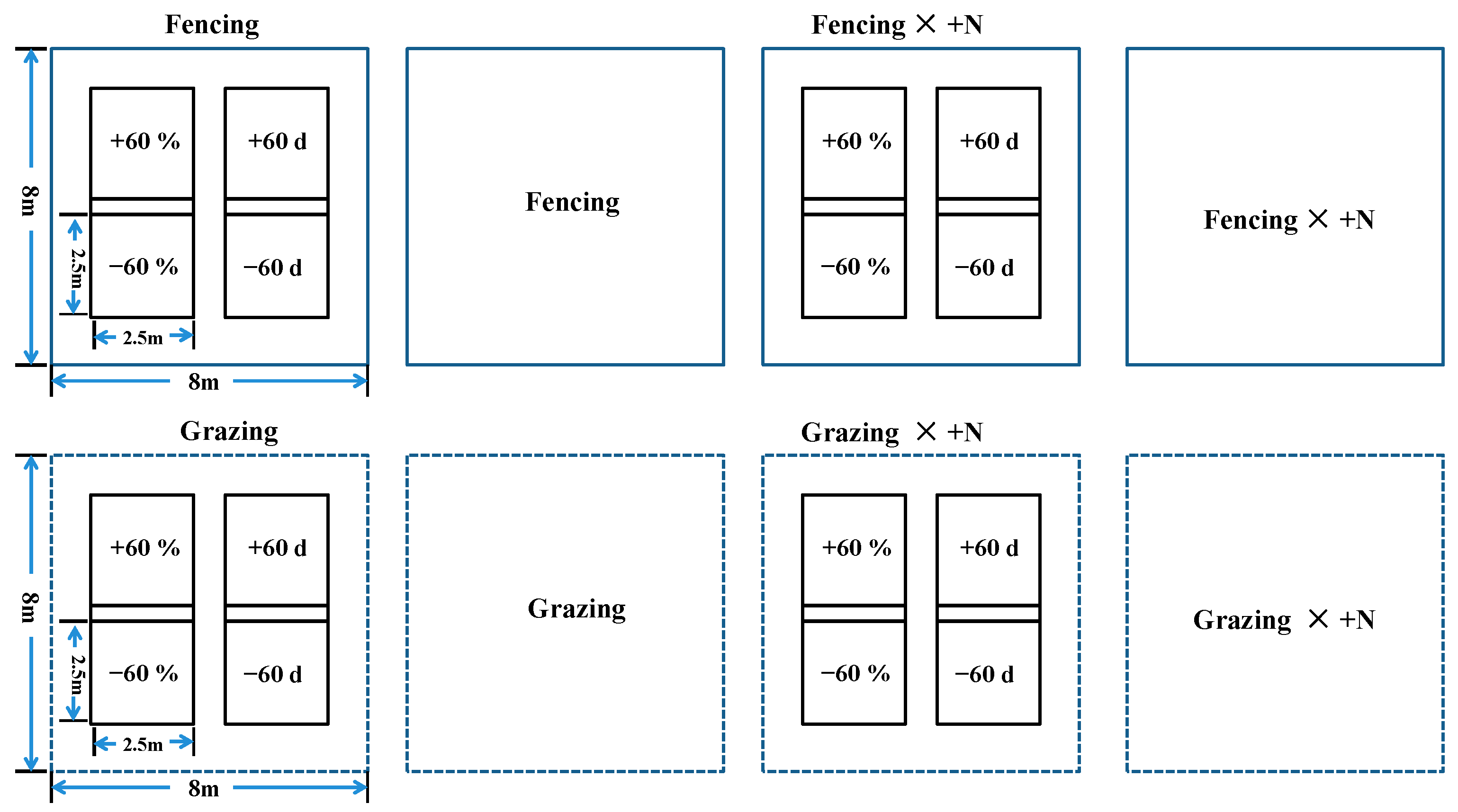

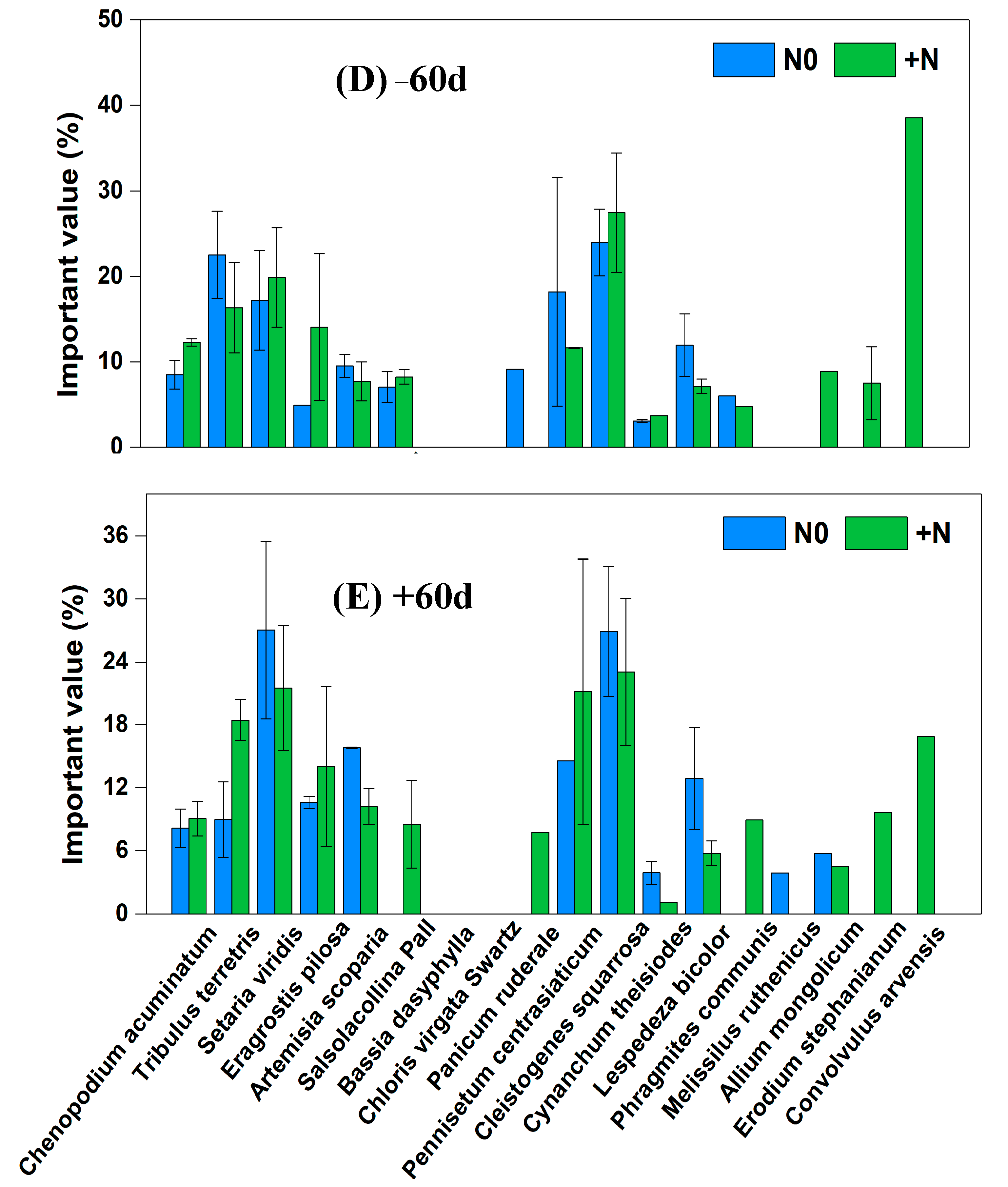
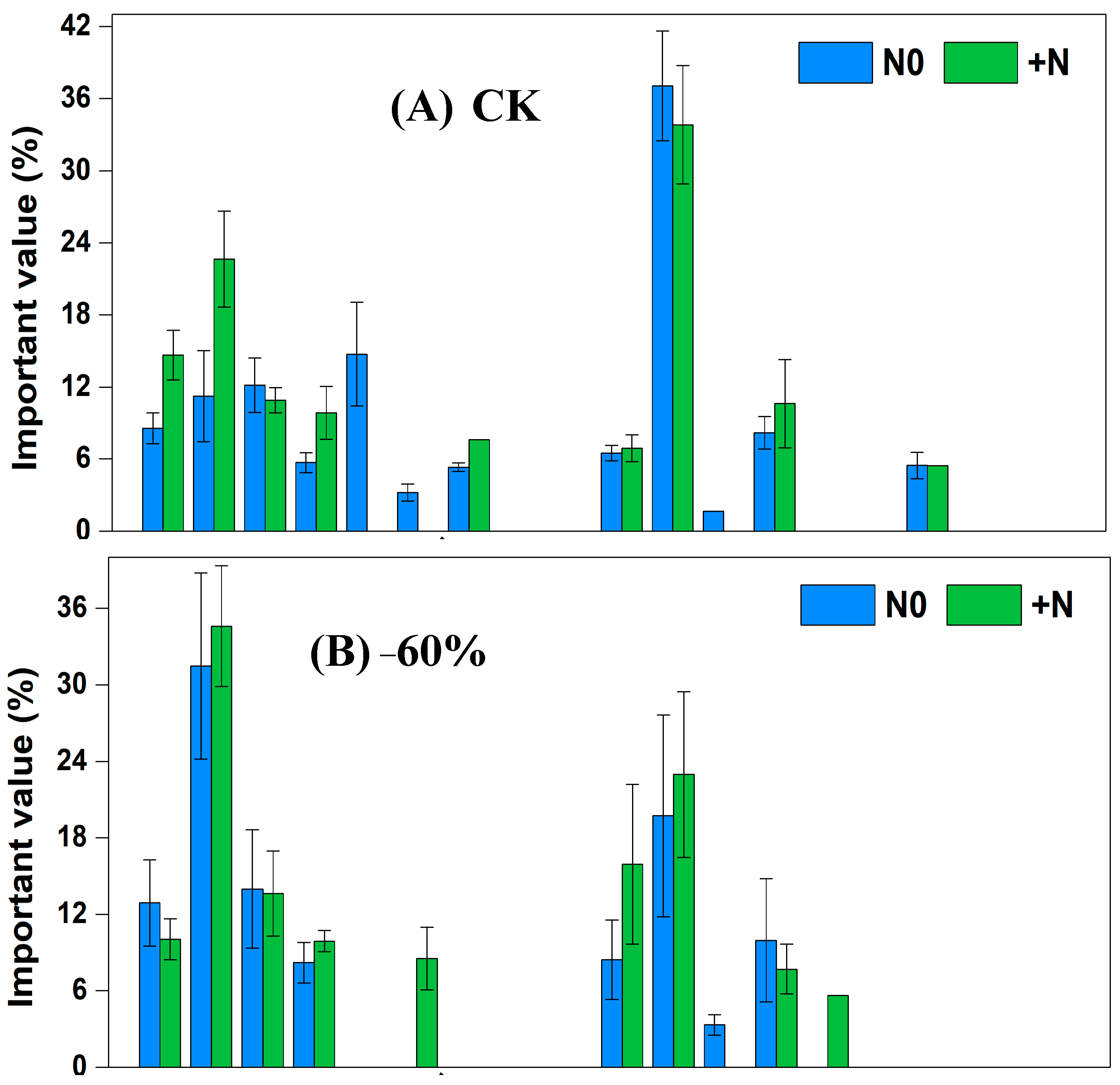

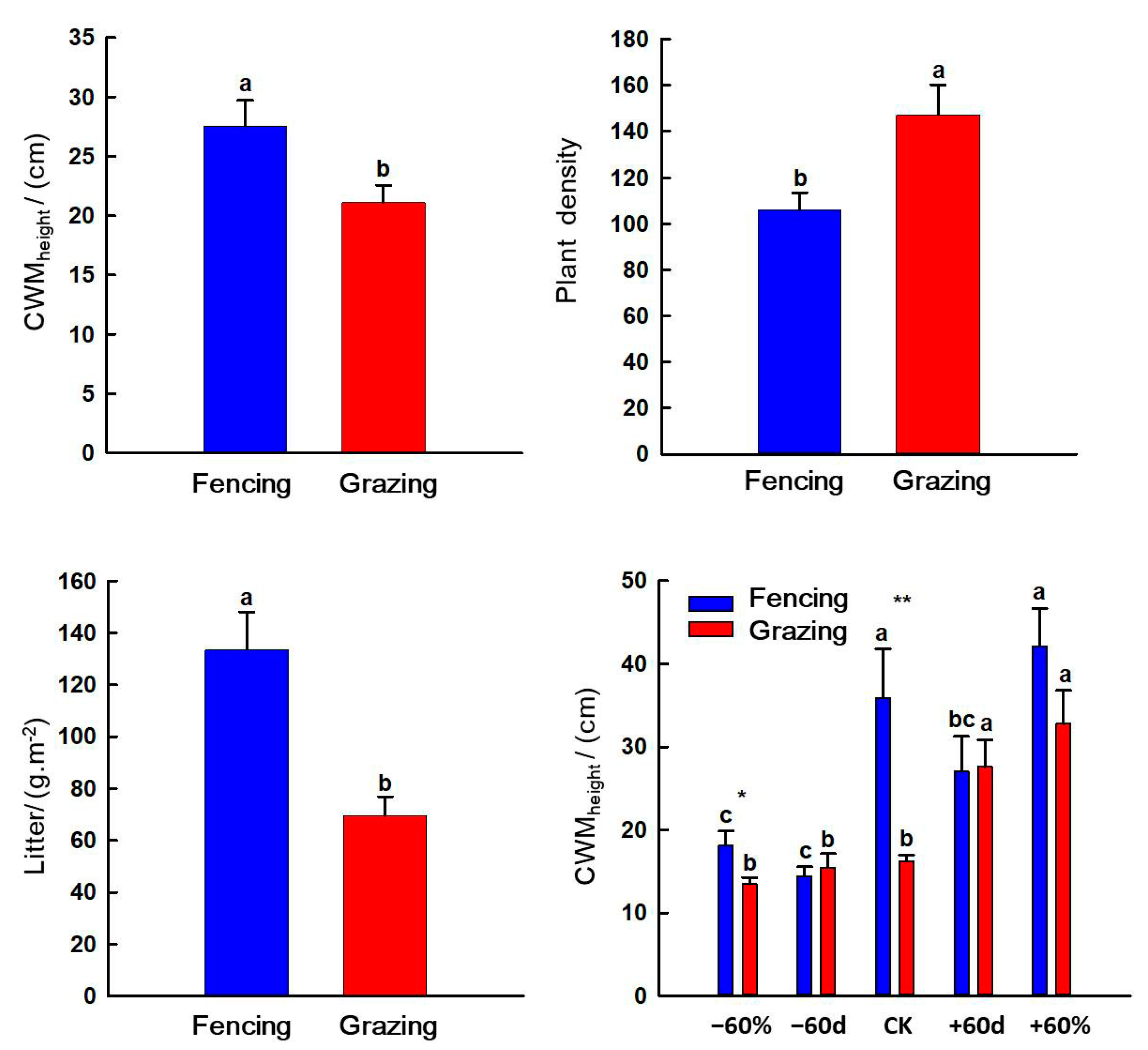



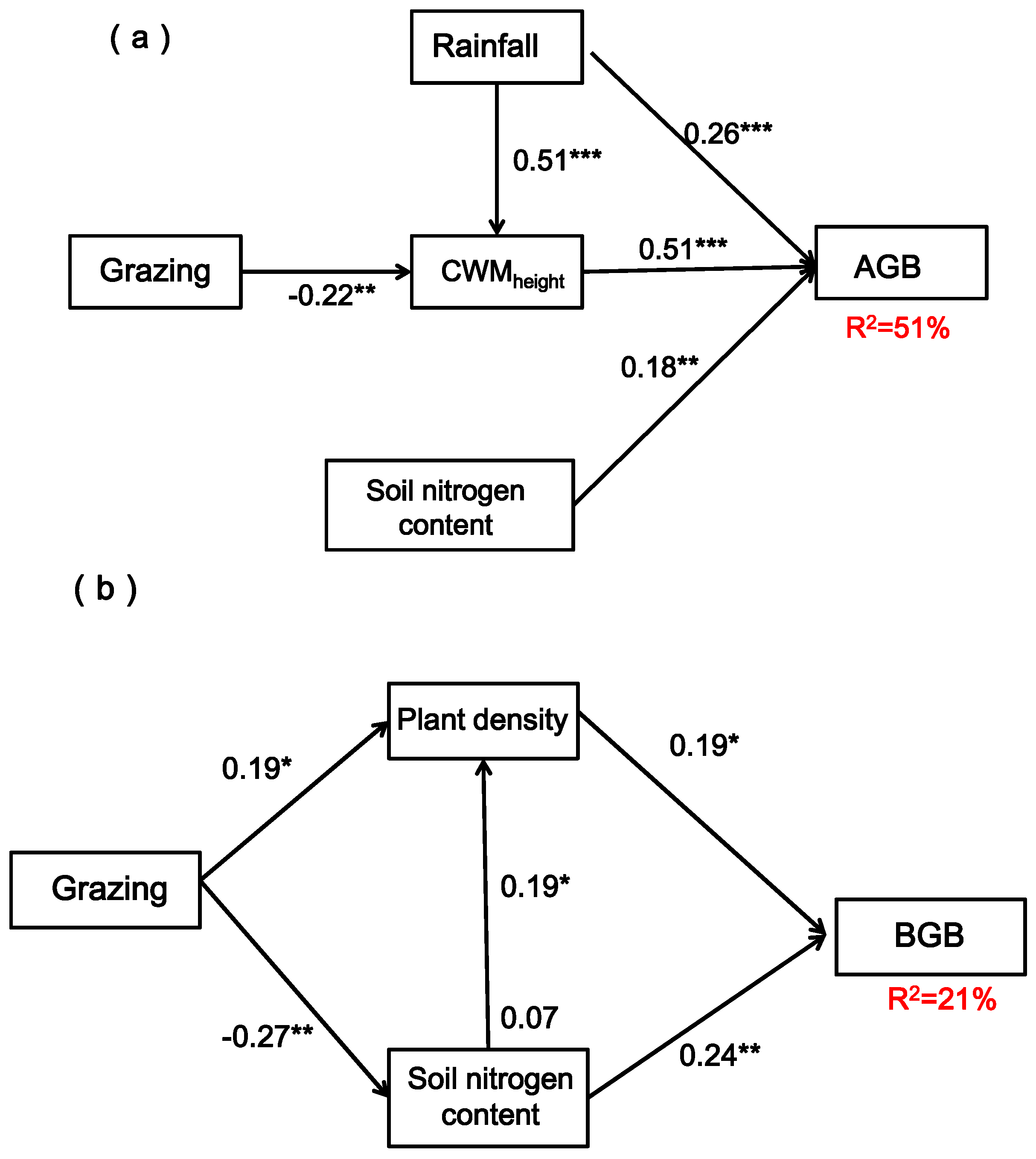
| Increasing Rainfall or Decreasing Rainfall Treatment | CK | −60% | 60% | −60 d | +60 d |
|---|---|---|---|---|---|
| Total rainfall (mm) | 376.36 | 150.55 | 602.18 | 270.30 | 482.44 |
| Rainfall in May (mm) | 35.17 | 14.07 | 56.27 | 0.00 | 70.34 |
| Rainfall in June (mm) | 70.91 | 28.36 | 113.45 | 0.00 | 141.82 |
| Rainfall in July (mm) | 108.19 | 43.28 | 173.11 | 108.19 | 108.19 |
| Rainfall in August (mm) | 162.09 | 64.84 | 259.35 | 162.09 | 162.09 |
| Treatment | CWMheight/ (cm) | Coverage/(%) | Species Richness | Plant Density | Litter Biomass/ (g·m−2) | D Index | H Index | J Index | AGB/(g·m−2) | BGB/(g·m−2) |
|---|---|---|---|---|---|---|---|---|---|---|
| Grazing | 9.47 ** | 0.10 | 0.13 | 8.20 ** | 14.94 ** | 5.25 | 3.43 | 4.64 | 1.49 | 0.21 |
| Rainfall | 15.76 ** | 48.76 ** | 1.93 | 3.30 * | 0.54 | 4.59 ** | 3.79 ** | 2.83 | 18.612 ** | 1.13 |
| nitrogen | 0.52 | 1.77 | 13.89 ** | 0.68 | 0.27 | 12.30 ** | 17.61 ** | 1.85 | 5.08 * | 0.05 |
| grazing×rainfall | 3.33 * | 0.74 | 1.19 | 1.09 | 0.38 | 1.46 | 1.49 | 0.82 | 0.49 | 0.20 |
| grazing×nitrogen | 0.38 | 2.02 | 3.25 | 1.86 | 0.52 | 0.03 | 1.28 | 0.66 | 0.01 | 1.06 |
| rainfall × nitrogen | 0.58 | 1.26 | 0.87 | 1.87 | 1.30 | 0.63 | 0.63 | 0.39 | 1.75 | 1.11 |
| grazing × rainfall × nitrogen | 1.59 | 1.26 | 0.70 | 0.79 | 1.31 | 2.33 | 1.97 | 1.15 | 0.18 | 0.56 |
Disclaimer/Publisher’s Note: The statements, opinions and data contained in all publications are solely those of the individual author(s) and contributor(s) and not of MDPI and/or the editor(s). MDPI and/or the editor(s) disclaim responsibility for any injury to people or property resulting from any ideas, methods, instructions or products referred to in the content. |
© 2023 by the authors. Licensee MDPI, Basel, Switzerland. This article is an open access article distributed under the terms and conditions of the Creative Commons Attribution (CC BY) license (https://creativecommons.org/licenses/by/4.0/).
Share and Cite
Zhang, J.; Zuo, X.; Lv, P. Effects of Grazing, Extreme Drought, Extreme Rainfall and Nitrogen Addition on Vegetation Characteristics and Productivity of Semiarid Grassland. Int. J. Environ. Res. Public Health 2023, 20, 960. https://doi.org/10.3390/ijerph20020960
Zhang J, Zuo X, Lv P. Effects of Grazing, Extreme Drought, Extreme Rainfall and Nitrogen Addition on Vegetation Characteristics and Productivity of Semiarid Grassland. International Journal of Environmental Research and Public Health. 2023; 20(2):960. https://doi.org/10.3390/ijerph20020960
Chicago/Turabian StyleZhang, Jing, Xiaoan Zuo, and Peng Lv. 2023. "Effects of Grazing, Extreme Drought, Extreme Rainfall and Nitrogen Addition on Vegetation Characteristics and Productivity of Semiarid Grassland" International Journal of Environmental Research and Public Health 20, no. 2: 960. https://doi.org/10.3390/ijerph20020960
APA StyleZhang, J., Zuo, X., & Lv, P. (2023). Effects of Grazing, Extreme Drought, Extreme Rainfall and Nitrogen Addition on Vegetation Characteristics and Productivity of Semiarid Grassland. International Journal of Environmental Research and Public Health, 20(2), 960. https://doi.org/10.3390/ijerph20020960





